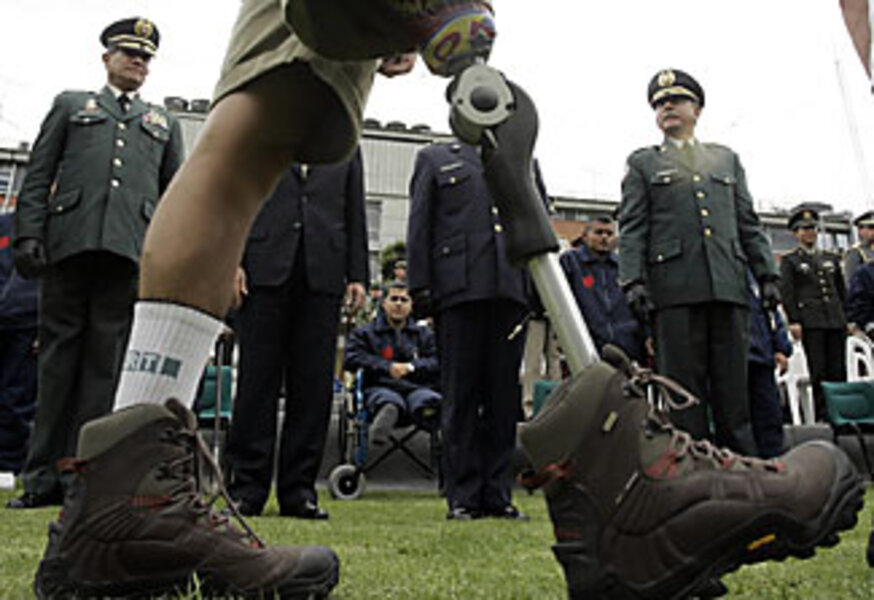In strategic shift, Colombia's FARC targets cities
Loading...
| Bogota, Colombia
The taps have run dry in the Colombian city of Villavicencio.
For more than a week, residents have been making do with buckets of water from trucks that circle the neighborhoods after the latest in a spate of urban bomb attacks that signal a shift in leftist guerrillas' strategy.
The flow of water to Villavicencio, a city of 300,000 on Colombia's eastern plains, was cut March 7 when three bombs tore through the main water line. Two days later, two policemen patrolling the water plant were severely injured by land mines.
The government offered a reward of $40,000 for information leading to the capture of those responsible. But Gen. Freddy Padilla, commander of Colombia's armed forces, says he has little doubt it was the guerrilla commander operating in that area who ordered the attack.
The bombing of the pipeline, he says, is part of a new campaign by the Revolutionary Armed Forces of Colombia (FARC), Colombia's largest rebel group, to make its power felt in the cities from which they had been pushed out through a sustained military and security campaign over the past five years.
"The FARC are opting to organize terrorist acts to show their presence as a force to the people of Colombia," General Padilla said in an interview. Based on military interceptions of FARC communications, the new strategy has been dubbed "Plan Renacer" or "Plan Rebirth."
Guerrillas regrouping
The FARC are regrouping after a series of severe setbacks last year, including the rescue of some of their more prized hostages and the deaths of three leaders, including the top commander and founder Manuel "Sureshot" Marulanda. Alfonso Cano, a more city-savvy guerrilla, took over the command of the rebel force, which the military estimates has some 8,000 fighters.
Officials said they are preparing for a possible major attack on March 26, the anniversary of Mr. Marulanda's death, apparently from natural causes.
The bomb that disrupted the aqueduct followed several other such attacks:
• On Jan. 16, a car packed with 88 pounds of explosives blew up at a shopping mall in the south-central city of Neiva.
• On Feb. 1, a car bomb blasted through the regional headquarters of the police intelligence service in the southwestern city of Cali, killing two. In September, a similar bomb went off in front of Cali's palace of justice.
•On March 6, a blast ripped through a hardware store and several other businesses in Neiva.
Some smaller attacks, Padilla says, appear to be related to extortion operations by the guerrillas. In February, a small bomb killed two people at a Blockbuster video store in a well-heeled neighborhood of Bogotà. Officials said Blockbuster had reported that the Colombian franchise of the company had been the victim of extortion demands that it refused to pay.
The FARC's strategy is to avoid combat situations with the military and concentrate on quick, clean attacks on infrastructure and urban areas.
Román Ortiz, a security analyst with the Ideas para la Paz (Ideas for Peace), a think tank in Bogotá, says the FARC are discovering what groups like Hamas in Israel and Shiite militias in Iraq have already concluded: that the cities are better than the jungles to wage war.
"The new jungles for the FARC are concrete jungles," he says. "When you cause damage in a city, the political impact is much larger than in the countryside."
Mr. Ortiz adds that, with the urban attacks, the FARC face a strategic dilemma. "They are probably looking for a balance between small attacks that are irrelevant and large-scale action that could in turn deepen the rejection of the population," he says.
Most of the recent blasts appear to have been calculated to cause the fewest civilian deaths, since most were detonated in the middle of the night. But the attack in Villavicencio was felt by 90 percent of the population there.
But Padilla says the desertions, captures, and the deaths of many FARC fighters over the past several years had forced the guerrillas to call on their urban militias to take up arms in the jungle, weakening their position in the cities.
"They tapped out their militias," he says. But the urban operatives that remain are "vital for their survival, because the militias are where they get their intelligence from and where they get their logistical support from – the ones who maintain connection with the population," Padilla adds.
Police successes
Weakened urban structures may be why police have been so successful in making arrests in the urban bombing cases. Less than two weeks after the Cali bomb in February, police captured six men believed to be members of the FARC's Manuel Cepeda Front. Less than a week after the February bomb in Neiva, two men were captured.
The FARC, Colombia's oldest and largest leftist guerrilla group, was founded in 1964 and reached a peak of nearly 20,000 fighters. After controlling large swaths of the country, a sustained military campaign under President Alvaro Uribe has pushed them into a retreat from major cities and diminished their military might.





